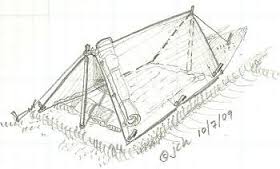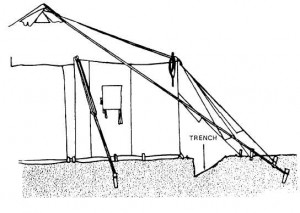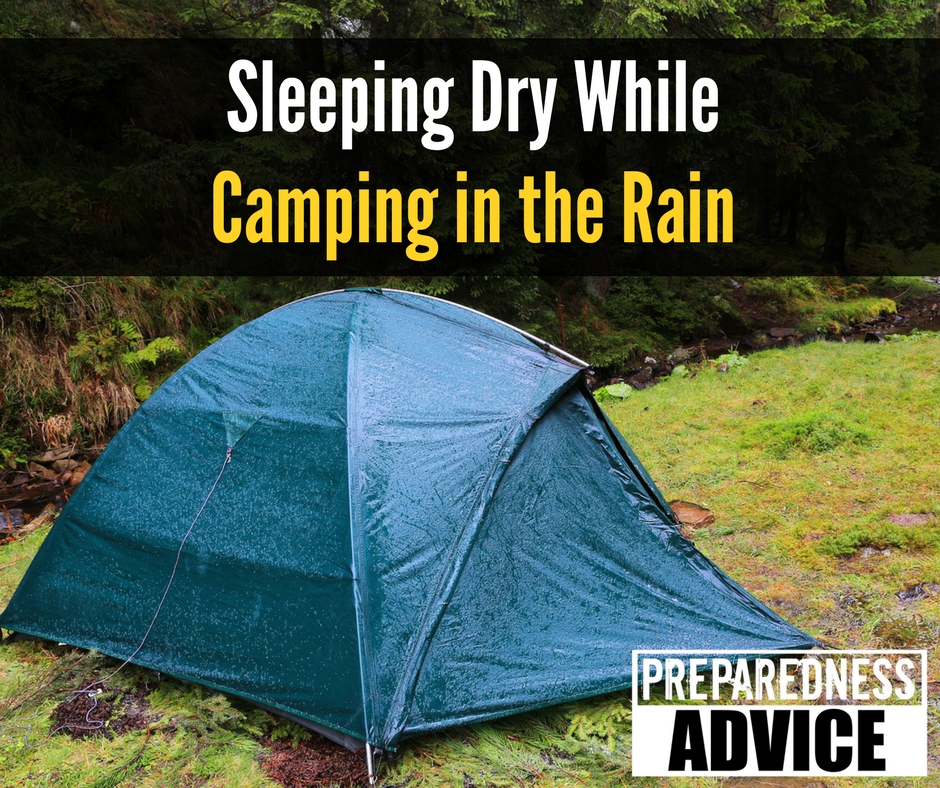
It has been raining hard on and off for the last several days. This resulted in a discussion about sleeping dry while camping in the rain. It’s surprising how little even experienced campers know about the subject, especially if they have generally camped during great weather or in drier locations. For them, the extent of their knowledge and preparedness comes down to depending on their tent alone to keep them dry.
Unless you want to end up with your gear soaked with water, soggy food, and wearing wet clothes, socks, and boots, here’s what you should know about sleeping dry.
There’s more to selecting a campsite than just a pretty view. You need to know how to How to Select a Campsite and have an understanding of how to build a drainage ditch around a tent if you suspect rain is in the forecast. Here are a few ideas to help you if you have to build a shelter in the rain and be sleeping dry even during a heavy downpour.
How to choose the right spot
First, choose a high spot for your tent, and don’t pitch your tent in an indentation which will become a puddle if it rains. Make sure you have good drainage around your tent. Most newer tents are made tub-style, meaning the floor fabric comes up the wall several inches, even forming a lip at the door, with as few seams as possible. They claim that this will prevent water from coming into your tent even if you are sitting in a shallow puddle.
When we had tents without floors, the old-school style of directing rain away from your tent was to dig a ditch all around it. They tell me that this is no longer an acceptable practice for environmental reasons, and due to the style and materials of modern tents, no longer necessary.
I seriously question this, and in any type of a real survival situation, if rain is a problem, I will dig a shallow ditch around my tent and drain the water off to the downhill side. In the past, this method was taught by both the military and the boy scouts and is time-proven.
Personally, I’ve experienced a soaking wet tent, and it’s no fun. We have a Base Camp tent from REI, and although the overall quality is excellent, in no way is it waterproof, even with the rainfly if there’s enough rain.
How to dig a drainage trench around your tent
So, if sleeping dry is a priority and rain is on the way, here’s how you can dig a drainage ditch around your tent.
-
- Dig the trench by cutting straight down just outside tent footprint. Do not dig in a V-shape. Slope the side away from the tent. Dig trench all around the tent
- Throw dirt from trench away from the tent; never throw it against the tent, for it will quickly rot the material.
- In most cases, do not dig trench more than 4 or 5 inches deep and in the shallowest place not over 3 inches. There should be enough slope in the trench so that the water will flow freely toward the outlet and not back up.
- To carry the water off, dig an outlet at the lowest point of the area and connect it to the trench which has been dug around the lent.
- When there is a possibility that the water may flow in from higher ground, dig a ditch to divert the water before it can reach the tent

Whether you are using a tent, tarp or another improvised shelter, if possible always point the opening downhill. If you live in an area that is subject to heavy rains and plan to camp out, have good tents and extra tarps.
If you look at the homeless camps during wet weather, most tents will have a tarp over them and often under them. If you put a tarp under your tent, be sure you fold the ends underneath so nothing is sticking out. If any part of the tarp is sticking out, it will funnel the water underneath your tent.
If you don’t have a sleeping pad or something to raise your sleeping bag off the ground, cut some brush or dry grass if it is available and put some padding between you and the ground.
If you live in an area that is subject to rainy weather, go camping in the rain. Try different types of shelters and see what works for you. Not too many years ago I went camping and used my old tent and a friend with me used his brand new 400 dollar tent. Guess which one leaked? The new one. Sleeping dry requires practice. Be sure and test your gear. This tent from Amazon comes with its own rain fly and comes in multiple sizes.




Sage advise as always. This kind of information is not taught near enough. I wonder what types of tarps are the best.
I have spent many rainy nights in a tent. Trenching will work, if the parks allow it. We always put a tub inside the tub. A cheap drop cloth inside the tent and a few clothes pins to keep it up. Nothing like waking up in a puddle and all your gear is DRY!
I’m an advocate for always using tarps above and below my tentage. Easier to keep the tent clean. Duck Tape comes in handy to cover leaks and small holes too.
If camping where trenching around tents is not permitted, a hammock suspended between two trees or sturdily constructed A-frame, protected by a suspended rain fly works well if it is not too windy. I have successfully used two hammocks suspended one above the other “bunk bed” style, using an upper at head height for gear storage and sleeping in the lower, both nets being screened from wind and rain by a A-frame rigged tarpaulin supplemented with a US Army poncho extending to the ground and staked windward side.
Pingback: Tips On Keeping Dry While Camping Outdoors | Living Dead Prepper
The tub inside a tub works well. Watch out for the tarp under a tent. It it overlaps the tent footprint then the rain sluicing off the tent will run under the tent unless the overhang slopes into the trench.
I’ve a little Quechua water proof 3 man tent that has withstood many thunder storms of 3″ or mare without a drop coming inside. Amazing tent.
I will never tent camp without a rain fly over the tent, usually extended 2 to 3 feet on the side walls, and 6 to 8 feet front and back. With the front slightly lower to add tarp drainage. 8 foot in the front makes a nice porch like for some soup and grilled cheese on the camp stove . . .
Not growing up in a camping family and then going off to USMC training, nature pointed out to me and my bud that, when trenching around a two-man ‘pup’ tent (two shelter halves), one does not throw the dirt ONTO the tent sides. Instead the dirt from the trench should be banked up inside the tent (dirt floor with ponchos and blankets) with the tent overhanging the trench. In this way the water runs down into the trench. The way we did it (the first time) funnels the water into the tent… 🙂 And the trench should have an outlet.
I’ve been wanting to camp in the wood albeit it’s raining. Tents are cool. It only show your a great survivalist.
Old thread but all good stuff. If you have the “door” zipped up and you don’t open it then a good tent with a rain fly will probably keep the inside mostly dry unless strong wind blows water through the vents. If your tent has vestibule, that will keep your boots/shoes mostly dry and is the place to store your wet rain gear. If you want to get in or out of your tent, you have to open the door and water will get in. A little water inside the tent will create a lot of misery – it makes your clothes wet, plays havoc with a down sleeping bag, and makes stuff slippery. A towel or sponge will help. A tarp or fly over the “door” will give you a dry spot to stand while taking off your boots and rain gear. Note: the tarp will create a semi-dry spot on the ground. If the soil is sandy and you don’t remove your shoes before entering the tent, your wet shoes will pick up sand in the damp spot and the sand will end up inside the tent. Add a little brush to go with the sponge or towel. Roll them into the tent when you put it away so they are always there when you need them. Bad news, the tarp will catch a the wind so you have to really tie it down. It is raining so the humidity is high, there will be condensation. The fun never ends. All the same things work with snow. Don’t be put off by the problems, they are minor. Get out there and enjoy it!